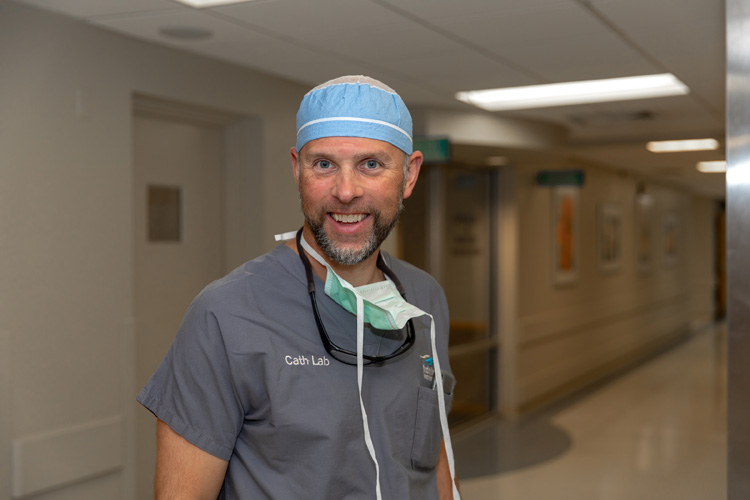
Trying to understand atrial fibrillation ablation is not for the faint of heart.
The procedure is used to treat irregular heart rhythms or arrhythmias that start in the heart’s upper chambers or atria. It does this by scarring or destroying live tissue inside the heart.
Your heart is a clean, green, wireless, battery-free generator of electricity. But it’s not immune to malfunctions. Few people know that better than Cleveland Clinic Indian River Hospital’s chief electrophysiologist, Dr. Brett Faulknier.
As the Mayo Clinic explains, “each beat of your heart is triggered by an electrical impulse normally generated from special cells in the upper right chamber of your heart. These signals are faulty in people who have atrial fibrillation, firing so rapidly that the upper chambers of your heart quiver (fibrillate) instead of beating efficiently. These rapidly discharging triggers are called hot spots. To restore a normal heart rhythm, the sources of these hot spots must be isolated from the rest of the heart.
“The most common technique for treating atrial fibrillation is catheter ablation. In this procedure, your doctor threads one or more long, thin tubes (catheters) through blood vessels to your heart. He or she uses a mapping catheter to determine where the over-active electrical triggers are located and then applies extreme cold or heat with the catheter tips to destroy or ablate these spots. This causes scarring that disrupts the faulty electrical signals and restores normal heart rhythms.”
The technique involves a ‘fire or ice’ approach, meaning it employs either radio-frequency generated heat or nitrous oxide-powered cold (minus 60 °F) to achieve its goal.
Some A-Fib patients are paroxysmal, which means, in Faulknier’s words, “they’re not always stuck in atrial fibrillation … they’re coming in and out of atrial fibrillation … they may have just a few episodes or they may have a lot of episodes.” Other patients have “persistent” A-Fib, meaning the heart is fluttering continuously.
For patients who still have some normal heart rhythm, Faulknier uses “more of the cryo-ablation [freezing] therapy,” while the radio-frequency heat treatment is more common with patients who have persistent A-Fib.
Armed with an iPhone full of statistics, Faulknier adds, “Atrial fibrillation is an exceedingly common age-related arrhythmia. Among people of European descent, the lifetime risk of developing atrial fibrillation after age 40 is 26 percent for men and 23 percent for women,” and A-Fib “increases your stroke risk probably about five to seven times” over those who don’t have atrial fibrillation.
“If a person is in the earlier stages of atrial fibrillation, then you legitimately have probably around about an 80- to 85-percent chance of dramatically reducing it” with atrial fibrillation ablation, Faulknier says, but he cautions an outright cure cannot to promised.
And the procedure itself is not without risk.
Threading multiple catheters from the groin up to and inside the heart, says the Mayo Clinic, may cause bleeding or infection at the site where the catheters are inserted, damage to blood vessels as those inserted tubes travel to the heart, punctures of the heart itself or damage to the heart valves, as well as development of blood clots in the legs or lungs.
Still, the American Heart Association says, while “medicines to treat rapid and irregular heartbeats work very well for most people, they don’t work for everyone and they may cause side effects in some people. In these cases, doctors may suggest catheter ablation.”
The AHA calls catheter ablation “a low-risk procedure that is successful in most people who have it” – provided your definition of success is a reduction of A-Fib events and not a complete end to them.
Faulknier says he is committed to give his patients the clearest understanding he can on these procedures. “I spend probably 45 minutes to an hour with the patient explaining what atrial fibrillation is, why it’s important in their life and what it means; then I get to the ablation [procedure] and try to explain it to them in a very succinct manner.”
Succinct maybe be an understatement as Faulknier sums up atrial fibrillation ablation by calling it “a big procedure [done] through small holes.”
Dr. Hugh Calkins, director of the electrophysiology lab at the Johns Hopkins School of Medicine and chairman of an international task force whose members include the Heart Rhythm Society, the American College of Cardiology, the American Heart Association and the Society of Thoracic Surgeons, estimates some 20,000 A-Fib ablation procedures will be performed in the United States this year.
That’s a lot of big procedures and even more small holes.
Dr. Brett Faulknier is the director of electrophysiology at the Cleveland Clinic Indian River Hospital in Vero Beach. He is also board certified in adult cardiovascular disease. His office is at 3450 11th Court, Suite 104. The phone number is 772-226-4830.



